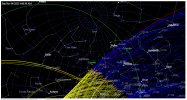HicSvntDracones
New Member
I love the video Scott Manley made that shows what the sky looks like if all satellites were visible. This got me thinking.. it would be highly useful to have a 360-degree simulator of the night sky and satellites, along with solar effects, such as orbital twilight. Primarily, I am interested in this because I have a theory that a lot of UAP reports, where an object is traveling one direction, then makes a 90-degree turn is actually 2 satellites in 2 different orbits crossing paths at the terminator, where one enters into darkness and another enters light. A realistic 360 degree simulator would let me validate this idea, along with being able to visualize the concept to others.
Anyone have a good suggestion of what to use? I know a lot of options exist, but looking for something that can show realistic views of satellites from the ground, including reflections and passing the day/night terminator.
Thanks
Anyone have a good suggestion of what to use? I know a lot of options exist, but looking for something that can show realistic views of satellites from the ground, including reflections and passing the day/night terminator.
Thanks
Last edited:

